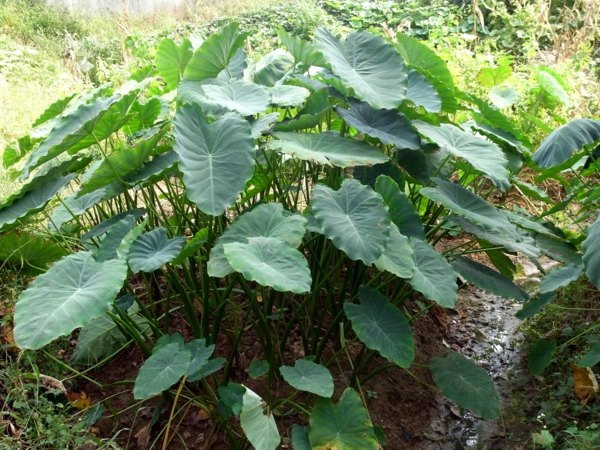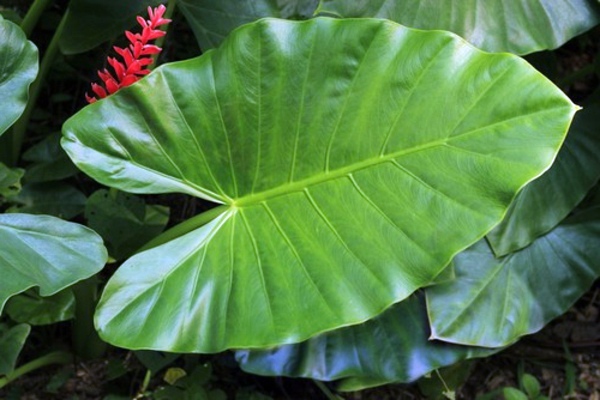Taro plant for your interior and exterior
Taro is a popular flower for home and garden, but it difficult and unusual natural features. If you show enough patience and care with respect to this evergreen plant, then you can have a real "trophy" in the garden. But of course, we want to warn you in advance before the plant is really hard! Here you can read our tips on how to grow taro in your home or garden. Taro (Colocasia esculenta) will surely impress you in all seasons in your living room – which is a beautiful evergreen plant with large heart-shaped leaves. With taro at home, you can certainly create an exotic atmosphere there. Other official names of the plant are taro, yams, eddoe, taro. Exposure
But people call him by the nickname "elephant ear", which can be explained by its large leaves
 Indication For the Taro you need more space at home, for his vigorous evergreen can grow up to 2 meters high. However, many people prefer to grow a plant outside. Taro flowers very rarely, this event is considered a great success among gardeners. The flowers are pale green and resemble those of Calla, but they should not have pleasant fragrance.
Indication For the Taro you need more space at home, for his vigorous evergreen can grow up to 2 meters high. However, many people prefer to grow a plant outside. Taro flowers very rarely, this event is considered a great success among gardeners. The flowers are pale green and resemble those of Calla, but they should not have pleasant fragrance.
The flowers are cut shortly after their appearance, because they cost more energy and tire factory

It may actually sound weird, but Taro should not have still only three leaves. With proper care, it can grow and develop wonderful 10 sheets. The principle here: more leaves, the worse the condition of the plant. Therefore, the gardener immediately remove the oldest when a new spell sheet. 3 The number of sheets should not interfere so. As you grow taro?
As stated above, Taro is evergreen, vigorous perennial, it forms rhizomes that grow both vertically and horizontally in the ground. Rhizomes are fleshy and have a diameter of 3 to 5 cm. Yes, Taro really requires a lot of care, but if you've learned to keep the factory, you will not have problems in the future. Taro is well with other plants, such as hydrangeas  One of the most important for good wetting of the plant growth conditions is the right amount of water, it
One of the most important for good wetting of the plant growth conditions is the right amount of water, it  Taro requires overwatering. If you overdo it, the roots can rot – which is actually one of the most common causes of plant diseases. Like Taro air temperatures around 21 degrees C and a constant humidity in the air. Caution, do not frost lighting taro Select a sunny corner house, it feels good in the vicinity of the window, but not in direct sunlight. The Taro comes from tropical regions, while he likes hot and humid atmosphere
Taro requires overwatering. If you overdo it, the roots can rot – which is actually one of the most common causes of plant diseases. Like Taro air temperatures around 21 degrees C and a constant humidity in the air. Caution, do not frost lighting taro Select a sunny corner house, it feels good in the vicinity of the window, but not in direct sunlight. The Taro comes from tropical regions, while he likes hot and humid atmosphere  Good soil here is the mixed soil: peat, sand, silt. It also requires good drainage. During the high season, from spring to fall, be sure to fertilize the plant. source of transplantation plant is propagated from cuttings. You will definitely need a larger pot when transplanting because the plant develops a strong root system. The best time for planting is late spring, when temperatures rise outside
Good soil here is the mixed soil: peat, sand, silt. It also requires good drainage. During the high season, from spring to fall, be sure to fertilize the plant. source of transplantation plant is propagated from cuttings. You will definitely need a larger pot when transplanting because the plant develops a strong root system. The best time for planting is late spring, when temperatures rise outside  Other information that may be considered Keep your Taro against pests such as aphids and mites. If the leaves turn yellow, then the air is too dry in your room and demanding plant needs more water. In the cold season, taro grows great in a conservatory, if you have such, you can place the plant there, she is determined to survive very cold winter. And that's what roots this culture
Other information that may be considered Keep your Taro against pests such as aphids and mites. If the leaves turn yellow, then the air is too dry in your room and demanding plant needs more water. In the cold season, taro grows great in a conservatory, if you have such, you can place the plant there, she is determined to survive very cold winter. And that's what roots this culture  Why "cris" Taro Taro when we see small drops of water on the leaves and wonder why the factory "cry." In fact, this process is called Guttation – which is the release of the water into drops of liquid in certain plants. The water is discharged, is ensured in spite of the water saturation of the transport of nutrients in the leaves. So drops of water on the leaves of taro are normally something quite normal, but you still have to watch taro leaves are toxic and can cause a variety of allergic reactions. The reason for the Guttation when Taro may constitute a violation of the leaf of the plant, so that you accidentally. According to legend, three taro leaves symbolize the three generations of women in a large family – grandmother, mother and daughter. And because we are very happy to have all three, "cry" the flower, if one of them dies. So you do not cry Taro, you can for a while reducing and observe how plants adapt to new conditions, the amount of water in irrigation. In the tropics, you can often see whole fields with Taro
Why "cris" Taro Taro when we see small drops of water on the leaves and wonder why the factory "cry." In fact, this process is called Guttation – which is the release of the water into drops of liquid in certain plants. The water is discharged, is ensured in spite of the water saturation of the transport of nutrients in the leaves. So drops of water on the leaves of taro are normally something quite normal, but you still have to watch taro leaves are toxic and can cause a variety of allergic reactions. The reason for the Guttation when Taro may constitute a violation of the leaf of the plant, so that you accidentally. According to legend, three taro leaves symbolize the three generations of women in a large family – grandmother, mother and daughter. And because we are very happy to have all three, "cry" the flower, if one of them dies. So you do not cry Taro, you can for a while reducing and observe how plants adapt to new conditions, the amount of water in irrigation. In the tropics, you can often see whole fields with Taro  We wish you much pleasure to take care of your plant taro!
We wish you much pleasure to take care of your plant taro!












